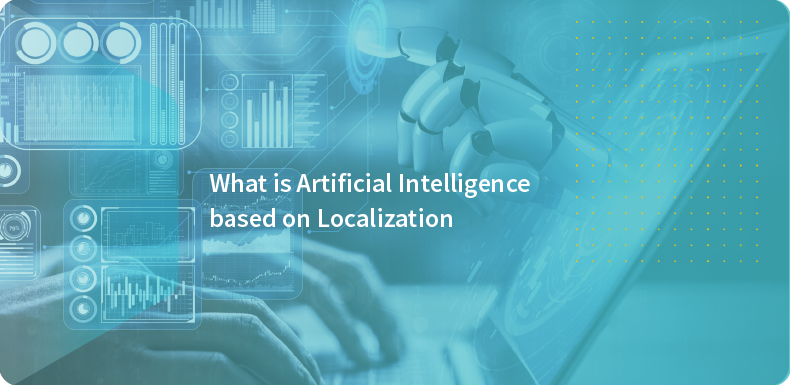
With the emergence of technology and the rapid technological advancements that occur daily, a variety of useful tools have been developed to satisfy human needs, one of which is Artificial Intelligence (AI).
Artificial Intelligence is one of the most desired and widely used technological tools and, it is worth noting, that AI outperforms humans in many ways. However, with the exponential growth of AI utilization comes the massive emergence of machine translation software, which not only provides numerous benefits, but also poses a threat to the future of linguists in the translation industry.
ACCORDING TO STATISTA, THE WORLD MARKET FOR AI TRANSLATION SOFTWARE, IN 2021, GREW BY 54%. FURTHERMORE, THE BREADTH OF THIS TECHNOLOGY IS SO BROAD THAT THIS MARKET IS EXPECTED TO REACH $22.6 BILLION BETWEEN 2020 AND 2025.
And, given that there are “between 6000 and 7000 active languages” now, as opposed to the “80 supported languages in Google Translate” and the “60 officially available languages in Microsoft Translator,” the demand for AI translation software development will only increase.
BENEFITS OF ARTIFICIAL INTELLIGENCE IN THE TRANSLATION INDUSTRY
Some, if not all, of the industry’s major companies realize the significance of AI translation software, and the following are just a few of the numerous translation advances that bridge the gap and break language/communication barriers: Google Neural Machine Translation, Voice Translator, Automatic Subtitle Translation, Google Lens, and DeepL. What these natural language processors all have in common is their Machine Learning (ML) feature –a computer algorithm that enables the software to improve automatically through experience, similar to the human brain.
On that note, below are some of the most significant benefits of AI translation technology in the translation field.
 Comprehensive Data Processing
Comprehensive Data Processing
Access to massive datasets and machines capable of processing them considerably more effectively than was previously possible is one of the primary drivers of powerful AI software being utilized for translation services. Google, for example, has been able to significantly improve its translation services, translating 300 trillion words in comparison to the professional translation industry’s predicted 200 billion words translated in 2020. And, while the accuracy of the AI translations isn’t always perfect, there have been substantial improvements over the years.
 Reduced Workforce
Reduced Workforce
The introduction of AI has resulted in a significant drop in job prospects in the translation industry. Machine translation, which is considerably easier to use and far faster to process than human translation, has significantly reduced the need for a translation workforce. The expansion of the machine learning-based educational system has, unintentionally, lowered the job prospects of professional translators.
 Language Learning Inclusivity
Language Learning Inclusivity
Language learning has become more fascinating and inclusive as a result of AI translation technology. Unlike in the past, when learning a foreign language required the assistance of a competent tutor at exorbitant fees, it is no longer as difficult. With the use of AI tools, language applications, and software, anyone may learn any language they desire.
Artificial intelligence is a strong and constantly improving technology. Its expansion may result in a large decline in translation jobs, but the benefits it provides in the translation industry will be intriguing to witness, as it will allow millions of people to easily access multiple languages.
THE FUTURE OF THE ARTIFICIAL INTELLIGENCE TRANSLATION INDUSTRY
When examining the effects of AI translation technology on the future of the translation industry, it is critical to consider the areas where AI falls short of human translation. Then we might be able to forecast what the future of the translation industry holds.
 The Personal Touch
The Personal Touch
What AI largely lacks is the human touch when translating a message from one language to another. It cannot have the same effect on an individual as it does on a group. AI translation technology cannot keep track of all the world’s dialects and tiny linguistic variations that differ regionally.
 Message Context
Message Context
Humans continue to outperform machines in terms of language because they contextualize the meaning of their words. The context is what gives the message its full significance. AI translation systems cannot always detect context and may misread a message. This is a significant shortcoming of AI translation technology.
 Human Connection
Human Connection
Culture is complex, and programs are still a long way from grasping its nuances and intricacies.
The translated content of a human interpreter exhibits unmatched human interaction and connection. It cannot be replaced by AI translation technology. While AI translation can considerably speed up and improve the translation process, it cannot provide the same accuracy and contextual requirements as a human translator or interpreter. Human translators and their requirements are relevant even in a highly evolved and technologically focused environment.

Conclusion
Almost all language norms and concrete translation requirements have been met by machine translation. However, one significant disadvantage is that AI is not responsive to the subjective parts of language and text. Language is subjective and continuously changing. AI technologies may be able to compensate for this shortcoming in the future, but for the time being, human translators are required to provide rapid solutions that are tailored to each translation project. “A fair depiction of the translation industry’s future may well be as computer-aided human translation or human-assisted machine translation.”
To summarize, AI systems have the potential to improve greatly due to their superior delivery of translation and interpretation solutions, as well as deep machine learning capabilities, but the human touch will always be required to enhance the impact of the content in the intended market.








